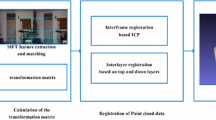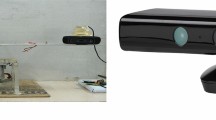Abstract
In this article we present a method for automatically recovering complete and dense depth maps of an indoor environment by fusing incomplete data for the 3D environment modeling problem. The geometry of indoor environments is usually extracted by acquiring a huge amount of range data and registering it. By acquiring a small set of intensity images and a very limited amount of range data, the acquisition process is considerably simplified, saving time and energy consumption. In our method, the intensity and partial range data are registered first by using an image-based registration algorithm. Then, the missing geometric structures are inferred using a statistical learning method that integrates and analyzes the statistical relationships between the visual data and the available depth on terms of small patches. Experiments on real-world data on a variety of sampling strategies demonstrate the feasibility of our method.
Similar content being viewed by others
Explore related subjects
Discover the latest articles, news and stories from top researchers in related subjects.References
Baker, S., & Kanade, T. (2002). Limits on super-resolution and how to break them. IEEE Transactions on Pattern Analysis and Machine Intelligence, 24(9), 1167–1183.
Boykov, Y., Veksler, O., & Zabih, R. (2001). Fast approximate energy minimization via graph cuts. IEEE Transactions on Pattern Analysis and Machine Intelligence, 23(11), 1222–1239.
Canny, J. (1986). A computational approach to edge detection. IEEE Transactions on Pattern Analysis and Machine Intelligence, 8(6), 679–698.
Cobzas, D. (2003). Image-based models with applications in robot navigation. PhD thesis, University of Alberta, Canada.
Connolly, C. I. (1984). Cumulative generation of octree models from range data. In Proceedings of the international conference on robotics (pp. 25–32), March 1984.
Criminisi, A., Perez, P., & Toyama, K. (2003). Object removal by exemplar-based inpainting. In IEEE computer vision and pattern recognition.
Davies, D. (1986). Uncertainty and how to treat it: modeling under uncertainty. In Proceedings of the first international conference on modeling under uncertainty (pp. 16–18), April 1986.
Diebel, J., & Thrun, S. (2005). An application of Markov random fields to range sensing. In Advances in neural information processing systems (NIPS) (pp. 291–298). Cambridge: MIT Press.
Efros, A., & Freeman, W. T. (2001). Image quilting for texture synthesis and transfer. In SIGGRAPH (pp. 1033–1038).
Efros, A., & Leung, T. K. (1999). Texture synthesis by non-parametric sampling. In IEEE international conference on computer vision (pp. 1033–1038), September 1999.
El-Hakim, S. F. (1998). A multi-sensor approach to creating accurate virtual environments. Journal of Photogrammetry and Remote Sensing, 53(6), 379–391.
Felzenszwalb, P. F., & Huttenlocher, D. P. (2006). Efficient belief propagation for early vision. International Journal of Computer Vision, 70(1), 41–54.
Fitzgibbon, A. W., & Zisserman, A. (1998). Automatic 3D model acquisition and generation of new images from video sequences. In Proceedings of European signal processing conference (pp. 1261–1269).
Freeman, W. T., & Adelson, E. H. (1991). The design and use of steerable filters. IEEE Transactions on Pattern Analysis and Machine Intelligence, 13(9), 891–906.
Freeman, W. T., & Torralba, A. (2003). Shape recipes: scene representations that refer to the image. In Advances in neural information processing systems (NIPS) (Vol. 15). Cambridge: MIT Press.
Freeman, W. T., Pasztor, E. C., & Carmichael, O. T. (2000). Learning low-level vision. International Journal of Computer Vision, 20(1), 25–47.
Fua, P. (1993). A parallel stereo algorithm that produces dense depth maps and preserves image feature. Machine Vision and Applications, 6, 35–49.
Geman, S., & Geman, D. (1984). Stochastic relaxation, Gibbs distributions, and the Bayesian restoration of images. IEEE Transactions on Pattern Analysis and Machine Intelligence, 6, 721–741.
Hammersley, J. M., & Clifford, P. (1971). Markov field on finite graphs and lattices. Unpublished.
Hertzmann, A., Jacobs, C. E., Oliver, N., Curless, B., & Salesin, D. H. (2001). Images analogies. In SIGGRAPH (pp. 327–340), August 2001.
Hoiem, D., Efros, A. A., & Herbert, M. (2005). Geometric context from a single image. In Proceedings of ICCV.
Howe, C. Q., & Purves, D. (2002). Range image statistics can explain the anomalous perception of length. Proceedings of the National Academy of Sciences, USA, 99, 13184–13188.
Kolmogorov, V., & Zabih, R. (2001). Computing visual correspondence with occlusions using graph cuts. In Proceedings ICCV (pp. 508–515).
Kuipers, B. (1978). Modelling spatial knowledge. Cognitive Science, 2, 1291–1353.
Lee, A., Pedersen, K., & Mumford, D. (2001). The complex statistics of high-contrast patches in natural images. Private correspondence.
Levoy, M., Pulli, K., Curless, B., Rusinkiewicz, S., Koller, D., Pereira, L., Ginzton, M., Anderson, S., Davis, J., Ginsberg, J., Shade, J., & Fulk, D. (2000). The digital Michelangelo project: 3D scanning of large statues. In Proceedings of ACM SIGGRAPH (pp. 131–144), July 2000.
Little, J. J., & Gillett, W. E. (1990). Direct evidence for occlusion in stereo and motion. Image and Vision Computing, 8, 328–340.
Michels, J., Saxena, A., & Ng, A. Y. (2005). High speed obstacle avoidance using monocular vision and reinforcement learning. In Proceedings of the 21th international conference on machine learning (ICML).
Nelson, W., & Cox, I. (1988). Local path control for an autonomous vehicle. In IEEE international conference on robotics and automation (pp. 1504–1510), New York, NY.
Nyland, L., McAllister, D., Popescu, V., McCue, C., Lastra, A., Rademacher, P., Oliveira, M., Bishop, G., Meenakshisundaram, G., Cutts, M., & Fuchs, H. (1999). The impact of dense range data on computer graphics. In Proceedings of multi-view modeling and analysis workshop (MVIEW part of CVPR) (p. 8), June 1999.
Poggio, T. A., Gamble, E. B., & Little, J. J. (1988). Parallel integration of vision modules. Science, 242, 436–439.
Pollefeys, M., Koch, R., Vergauwen, M., & Van Gool, L. (1998). Metric 3D surface reconstruction from uncalibrated images sequences. In Proceedings of SMILE workshop (post-ECCV) (pp. 138–153).
Potetz, B., & Lee, T. S. (2003). Statistical correlations between 2D images and 3D structures in natural scenes. Journal of Optical Society of America, 20(7), 1292–1303.
Pulli, K., Cohen, M., Duchamp, T., Hoppe, H., McDonald, J., Shapiro, L., & Stuetzle, W. (1997). Surface modeling and display from range and color data. In Lecture notes in computer science (Vol. 1310, pp. 385–397). Berlin: Springer.
Saxena, A., Chung, S. H., & Ng, A. Y. (2006). Learning depth from single monocular images. In Proceedings of the advances in neural information processing systems (NIPS). Cambridge: MIT Press.
Saxena, A., Schulte, J., & Ng, A. Y. (2007). Depth estimation using monocular and stereo cues. In Proceedings of international joint conference on artificial intelligence (IJCAI).
Scharstein, D., & Szeliski, R. (2002). A taxonomy and evaluation of dense two-frame stereo correspondence algorithms. International Journal of Computer Vision, 47(7), 7–42.
Scharstein, D., & Szeliski, R. (2003). High-accuracy stereo depth maps using structured light. In IEEE CVPR (Vol. 1, pp. 195–202).
Sequeira, V., Ng, K., Wolfart, E., Goncalves, J. G. M., & Hogg, D. C. (1999). Automated reconstruction of 3D models from real environments. ISPRS Journal of Photogrammetry and Remote Sensing, 54, 1–22.
Shafer, G. (1976). Mathematical theory of evidence. Princeton: Princeton University Press.
Stamos, I., & Allen, P. K. (2000). 3D model construction using range and image data. In CVPR, June 2000.
Stan, Z. (1995). In T. L. Kunii (Ed.), Computer science workbench. Li–Markov random field modeling in image analysis. Berlin: Springer.
Sun, J., Zheng, N., & Shum, H. (2003). Stereo matching using belief propagation. IEEE Transactions on Pattern Analysis and Machine Intelligence, 25(7), 787–800.
Sun, J., Li, Y., Kang, S., & Shum, H.-Y. (2005). Symmetric stereo matching for occlusion handling. In Proceedings CVPR (Vol. II, pp. 399–406).
Szeliski, R., Zabih, R., Scharstein, D., Veksler, O., Kolmogorov, V., Agarwala, A., Tappen, M., & Rother, C. (2006). A comparative study of energy minimization methods for Markov random fields. In ECCV (Vol. 2, pp. 19–26).
Tomasi, C., & Kanade, T. (1992). Shape and motion from image streams under orthography: a factorization approach. International Journal of Computer Vision, 9(2), 137–154.
Torralba, A., & Oliva, A. (2002). Depth estimation from image structure. IEEE Transactions on Pattern Analysis and Machine Intelligence, 24(9), 1226–1238.
Torres-Méndez, L.A. (2005). Statistics of visual and partial depth data for mobile robot environment modeling. PhD thesis, McGill University.
Torres-Méndez, L. A., & Dudek, G. (2002). Range synthesis for 3D environment modeling. In IEEE workshop on applications of computer vision (pp. 231–236), Orlando, FL.
Torres-Méndez, L. A., & Dudek, G. (2004a). Statistical inference and synthesis in the image domain for mobile robot environment modeling. In Proceedings of the IEEE/RSJ conference on intelligent robots and systems (IROS), September 2004. New York: IEEE Press.
Torres-Méndez, L. A., & Dudek, G. (2004b). Reconstruction of 3D models from intensity image and partial depth. In AAAI proceedings (pp. 476–481), July 2004.
Torres-Méndez, L. A., & Dudek, G. (2006). Statistics of visual and partial depth data for mobile robot environment modeling. In A. Gelbukh & C. A. Reyes-Garca (Eds.), Lecture notes in artificial intelligence : Vol. 4293. Mexican international conference on artificial intelligence (pp. 715–725). Berlin: Springer.
Wei, L., & Levoy, M. (2000). Fast texture synthesis using tree-structured vector quantization. In SIGGRAPH (pp. 479–488), July 2000.
Whaite, P., & Ferrie, F. P. (1997). Autonomous exploration: driven by uncertainty. IEEE Transactions on Pattern Analysis and Machine Intelligence, 19(3), 193–205.
Winkler, G. (1995). Image analysis, random fields, and dynamic Monte Carlo methods: a mathematical introduction. Berlin: Springer.
Zhang, L., & Seitz, S. M. (2005). Parameter estimation for MRF stereo. In CVPR (Vol. 2, pp. 288–295).
Zhang, R., Tsai, P.-S., Cryer, J. E., & Shah, M. (1999). Shape from shading: a survey. IEEE Transactions on Pattern Analysis and Machine Intelligence, 21(8), 690–706.
Author information
Authors and Affiliations
Corresponding author
Electronic Supplementary Material
Rights and permissions
About this article
Cite this article
Torres-Méndez, L.A., Dudek, G. Inter-Image Statistics for 3D Environment Modeling. Int J Comput Vis 79, 137–158 (2008). https://doi.org/10.1007/s11263-007-0108-2
Received:
Accepted:
Published:
Issue Date:
DOI: https://doi.org/10.1007/s11263-007-0108-2




